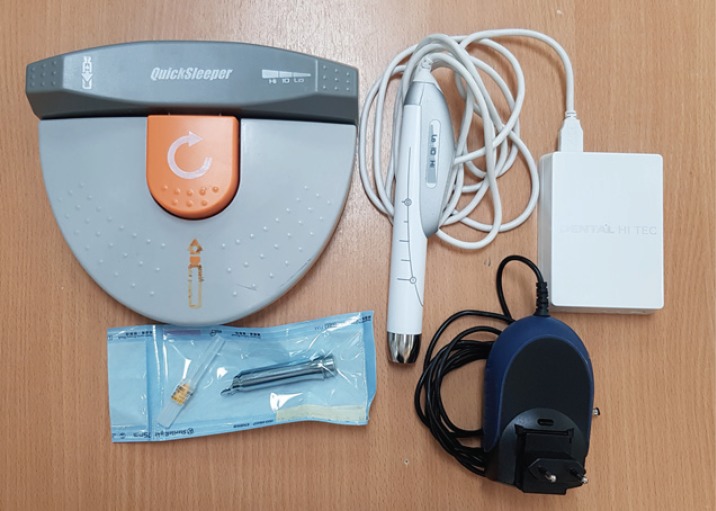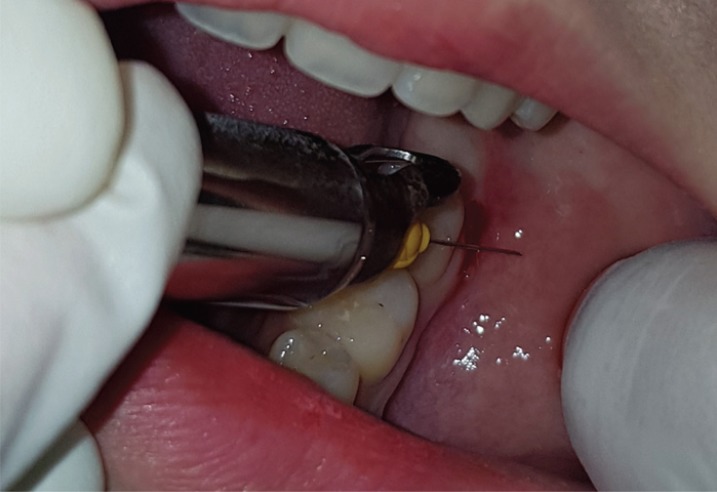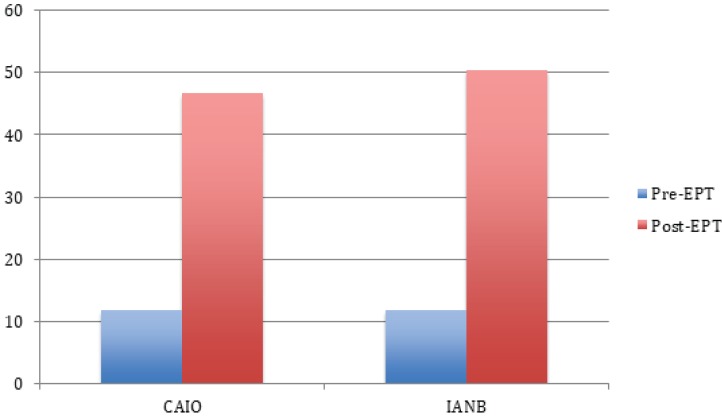J Dent Anesth Pain Med.
2018 Dec;18(6):339-347. 10.17245/jdapm.2018.18.6.339.
Inferior alveolar nerve block by intraosseous injection with Quicksleeper® at the retromolar area in mandibular third molar surgery
- Affiliations
-
- 1Department of Oral & Maxillofacial Surgery, Faculty of Dentistry, Mahidol University, Bangkok, Thailand. natthamet.won@mahidol.ac.th
- KMID: 2430211
- DOI: http://doi.org/10.17245/jdapm.2018.18.6.339
Abstract
- BACKGROUND
There are many techniques of inferior alveolar nerve block injection (IANBI); one among them is the computer-assisted intraosseous injection (CAIOI). Here we aim to evaluate the effectiveness of CAIOI with Quicksleeper® in mandibular third molar surgery.
METHODS
This study is a clinical, single-blind, randomized, split-mouth, controlled trial including 25 patients (10 males and 15 females, mean age 21 years). The patients underwent surgical removal of bilateral mandibular third molars with two different IANBI techniques. One side was injected using Quicksleeper®, and the other side was injected using a conventional IANBI. Both techniques used one cartridge (1.7 ml) of 1:100,000 epinephrine 4% articaine. A supplementary injection was used if necessary. All volumes of anesthetic agent used were recorded. Statistical analysis was performed using paired t-test and Wilcoxon test.
RESULTS
This research showed that CAIOI has faster onset and shorter duration of action than IANBI (P < 0.05). The pain was similar in both techniques. In the CAIOI group, one-third of the cases could be completed without additional anesthesia. The remaining two-thirds required minimal supplementary volume of anesthesia. The success rates were 68% for CAIOI and 72% for IANBI, respectively.
CONCLUSION
CAIOI is an advantageous anesthetic technique. It can be used as an alternative to conventional IANBI for mandibular third molar surgery.
Keyword
MeSH Terms
Figure
Cited by 2 articles
-
Alternative techniques for failure of conventional inferior alveolar nerve block
Choi Ryang Lee, Hoon Joo Yang
J Dent Anesth Pain Med. 2019;19(3):125-134. doi: 10.17245/jdapm.2019.19.3.125.Clinical evaluation of efficacy of transcortical anesthesia for the extraction of impacted mandibular third molars: a randomized controlled trial
Esin Demir, Hanife Ataoglu
J Dent Anesth Pain Med. 2020;20(1):9-17. doi: 10.17245/jdapm.2020.20.1.9.
Reference
-
1. Malamed SF. Handbook of Local Anesthesia. 6th ed. St. Louis: Mosby;Elsevier;2013.2. Wong JK. Adjuncts to Anesthesia: Separating Fact to Fiction. J Can Dent Assoc. 2001; 67:391–397. PMID: 11468097.3. Graetz C, Fawzy-El-Sayed KM, Graetz N, Dorfer CE. Root damage induced by intraosseous anesthesia. An in vitro investigation. Med Oral Patol Oral Cir Bucal. 2013; 18:e130–e134. PMID: 23229260.4. Woodmansey KF, White RK, He J. Osteonecrosis related to intraosseous anesthesia: Report of a case. J Endod. 2009; 35:288–291. PMID: 19166792.
Article5. Remmers T, Glickman G, Spears R, He J. The efficacy of IntraFlow intraosseous injection as a primary anesthesia technique. J Endod. 2008; 34:280–283. PMID: 18291275.
Article6. Nusstein J, Reader A, Nist R, Beck M, Meyers WJ. Anesthetic efficacy of the supplemental intraosseous injection of 2% lidocaine with 1:100,000 epinephrine in irreversible pulpitis. J Endod. 1998; 24:487–491. PMID: 9693577.
Article7. Reisman D, Reader A, Nist R, Beck M, Weaver J. Anesthetic efficacy of the supplemental intraosseous injection of 3% mepivacaine in irreversible pulpitis. Oral Surg Oral Med Oral Pathol Oral Radiol Endod. 1997; 84:676–682. PMID: 9431539.
Article8. Bigby J, Reader A, Nusstein J, Beck M, Weaver J. Articaine for supplemental intraosseous anesthesia in patients with irreversible pulpitis. J Endod. 2006; 32:1044–1047. PMID: 17055903.
Article9. Parente SA, Anderson RW, Herman WW, Kimbrough WF, Weller RN. Anesthetic efficacy of the supplemental intraosseous injection for teeth with irreversible pulpitis. J Endod. 1998; 24:826–828. PMID: 10023263.
Article10. Pereira LA, Groppo FC, Bergamaschi Cde C, Meechan JG, Ramacciato JC, Motta RH, et al. Articaine (4%) with epinephrine (1:100,000 or 1:200,000) in intraosseous injections in symptomatic irreversible pulpitis of mandibular molars: anesthetic efficacy and cardiovascular effects. Oral Surg Oral Med Oral Pathol Oral Radiol. 2013; 116:e85–e91. PMID: 22841432.
Article11. Demir E, Ataoglu H. Clinic evaluation of efficacy of transcotical anesthesia for extraction of impacted third molars. Br J Oral Maxillofac Surg. 2016; 54:e100.
Article12. Kiattavorncharoen S, Wongsirichat N, Boonsiriseth K. The anesthesia efficacy of intraosseous injection with Quicksleeper® and conventional injection in the lower third molar surgery. M Dent J. 2013; 33:137–143.13. Ozer S, Yaltirik M, Kirli I, Yargic I. A comparative evaluation of pain and anxiety levels in 2 different anesthesia techniques: locoregional anesthesia using conventional syringe versus intraosseous anesthesia using a computer-controlled system (Quicksleeper®). Oral Surg Oral Med Oral Pathol Oral Radiol. 2012; 114(5 suppl):S132–S139. PMID: 23063389.14. Smail-Faugeron V, Muller-Bolla M, Sixou JL, Courson F. Split-mouth and parallel-arm trials to compare pain with intraosseous anaesthesia delivered by the computerised Quicksleeper system and conventional infiltration anaesthesia in paediatric oral healthcare: protocol for a randomised controlled trial. BMJ Open. 2015; 5:e007724.
Article15. González-Castro O, Arias A. Controlled flow of dental anesthesia solution to reduce pain and anxiety. Int J Clin Anesthesiol. 2017; 5:1075.16. Dunbar D, Reader A, Nist R, Beck M, Meyers WJ. Anesthetic efficacy of the intraosseous injection after an inferior alveolar nerve block. J Endod. 1996; 22:481–486. PMID: 9198431.
Article17. Replogle K, Reader A, Nist R, Beck M, Weaver J, Meyers WJ. Anesthetic efficacy of the intraosseous injection of 2% lidocaine (1:100,000 epinephrine) and 3% mepivacaine in mandibular first molars. Oral Surg Oral Med Oral Pathol Oral Radiol Endod. 1997; 83:30–37. PMID: 9007920.
Article18. Jensen J, Nusstein J, Drum M, Reader A, Beck M. Anesthetic Efficacy of a Repeated Intraosseous Injection Following a Primary Intraosseous Injection. J Endod. 2008; 34:126–130. PMID: 18215666.
Article19. Beneito-Brotons R, Penarrocha-Oltra D, Ata-Ali J, Penarrocha M. Intraosseous anesthesia with solution injection controlled by a computerized system versus conventional oral anesthesia: a preliminary study. Med Oral Patol Oral Cir Bucal. 2012; 17:e426–e429. PMID: 22143722.
Article20. Prohic S, Sulejmanagic H, Secic S. The efficacy of supplemental intraosseous anesthesia after insufficient mandibular block. Bosn J Basic Med Sci. 2005; 5:57–60. PMID: 15771604.21. Terrer É TF, Coudrec G, Vialatte L, Tramini P, Tassery H. Anesthesie osteo-centrale versus locoregional du bloc du nerf dentaire inferieur. L’information Dentaire. 2014; 35:e007724.22. Cabasse C, Marie-Cousin A, Huet A, Sixou JL. Computer-assisted intraosseous anaesthesia for molar and incisor hypomineralisation teeth. A preliminary study. Odontostomatol Trop. 2015; 38:5–9.23. Couderc G, Weisrock G, Tassery H. L’anesthésie transcorticale dans la prise en charge des urgences d’un centre de soins hospitalo-universitaire. Le Fil Dentaire. 2009; 43.24. Chang H, Noh J, Lee J, Kim S, Koo KT, Kim TI, et al. Relief of Injection Pain During Delivery of Local Anesthesia by Computer-Controlled Anesthetic Delivery System for Periodontal Surgery: Randomized Clinical Controlled Trial. J Periodontol. 2016; 87:783–789. PMID: 26991489.
Article25. Han K, Kim J. Intraosseous anesthesia using a computer-controlled system during non-surgical periodontal therapy (root planing): Two case reports. J Dent Anesth Pain Med. 2018; 18:65–69. PMID: 29556561.
Article26. Kim C, Hwang KG, Park CJ. Local anesthesia for mandibular third molar extraction. J Dent Anesth Pain Med. 2018; 18:287–294. PMID: 30402548.
Article27. Demir E, Ataoglu H. Clinic evaluation of efficacy of transcotical anesthesia for extraction of impacted third molars. Br J Oral Maxillofac Surg. 2016; 54:e100.
Article
- Full Text Links
- Actions
-
Cited
- CITED
-
- Close
- Share
- Similar articles
-
- Updates on the Inferior Alveolar Nerve Block Anesthesia
- Facial blanching after inferior alveolar nerve block anesthesia: an unusual complication
- Morphometric study on mandibular foramen and incidence of accessory mandibular foramen in mandibles of south Indian population and its clinical implications in inferior alveolar nerve block
- Study On The Relationship Of The Inferior Alveolar Nerve Position Between Buccal And Lingual Side Using Ct And Orthpantomogram
- The study of evaluation to relationship between the inferior alveolar nerve and the mandibular third molar by using radiographic image




